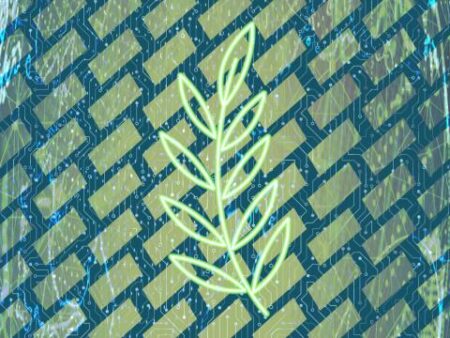Jul
8
New Material Created to Capture Light Energy
July 8, 2021 | Leave a Comment
Inspired by nature, Pacific Northwest National Laboratory researchers have created a novel material capable of capturing light energy. The new material provides a highly efficient artificial light-harvesting system with potential applications in photovoltaics and bioimaging.

POSS-peptoid molecules self-assemble into rhomboid-shaped nanocrystals. Image Credit: Illustration by Stephanie King, Pacific Northwest National Laboratory. Click image for the largest view.
The research provides a foundation for overcoming the difficult challenges involved in the creation of hierarchical functional organic-inorganic hybrid materials. Nature provides beautiful examples of hierarchically structured hybrid materials such as bones and teeth. These materials typically showcase a precise atomic arrangement that allows them to achieve many exceptional properties, such as increased strength and toughness.
PNNL materials scientist Chun-Long Chen, corresponding author of this study, and his collaborators created a new material that reflects the structural and functional complexity of natural hybrid materials. This material combines the programmability of a protein-like synthetic molecule with the complexity of a silicate-based nanocluster to create a new class of highly robust nanocrystals. They then programmed this 2D hybrid material to create a highly efficient artificial light-harvesting system.
Chen said, “The sun is the most important energy source we have. We wanted to see if we could program our hybrid nanocrystals to harvest light energy – much like natural plants and photosynthetic bacteria can – while achieving a high robustness and processibility seen in synthetic systems.”
The results of this study have been published in Science Advances.
Though these types of hierarchically structured materials are exceptionally difficult to create, Chen’s multidisciplinary team of scientists combined their expert knowledge to synthesize a sequence-defined molecule capable of forming such an arrangement.
The researchers created an altered protein-like structure, called a peptoid, and attached a precise silicate-based cage-like structure (abbreviated POSS) to one end of it. They then found that, under the right conditions, they could induce these molecules to self-assemble into perfectly shaped crystals of 2D nanosheets. This created another layer of cell-membrane-like complexity similar to that seen in natural hierarchical structures while retaining the high stability and enhanced mechanical properties of the individual molecules.
“As a materials scientist, nature provides me with a lot of inspiration” said Chen. “Whenever I want to design a molecule to do something specific, such as act as a drug delivery vehicle, I can almost always find a natural example to model my designs after.”
Once the team successfully created these POSS-peptoid nanocrystals and demonstrated their unique properties including high programmability, they then set out to exploit these properties. They programmed the material to include special functional groups at specific locations and intermolecular distances. Because these nanocrystals combine the strength and stability of POSS with the variability of the peptoid building block, the programming possibilities were endless.
Once again looking to nature for inspiration, the scientists created a system that could capture light energy much in the way pigments found in plants do. They added pairs of special “donor” molecules and cage-like structures that could bind an “acceptor” molecule at precise locations within the nanocrystal. The donor molecules absorb light at a specific wavelength and transfer the light energy to the acceptor molecules. The acceptor molecules then emit light at a different wavelength. This newly created system displayed an energy transfer efficiency of over 96%, making it one of the most efficient aqueous light-harvesting systems of its kind reported thus far.
To showcase the use of this system, the researchers then inserted the nanocrystals into live human cells as a biocompatible probe for live cell imaging. When light of a certain color shines on the cells and the acceptor molecules are present, the cells emit a light of a different color. When the acceptor molecules are absent, the color change is not observed. Though the team only demonstrated the usefulness of this system for live cell imaging so far, the enhanced properties and high programmability of this 2D hybrid material leads them to believe this is one of many applications.
“Though this research is still in its early stages, the unique structural features and high energy transfer of POSS-peptoid 2D nanocrystals have the potential to be applied to many different systems, from photovoltaics to photocatalysis,” said Chen. He and his colleagues will continue to explore avenues for application of this new hybrid material.
While the press release is rather difficult to ascertain just what the researchers have found that applies to energy, the key clue is in the ability of the material to shift light wavelengths – hopefully to the frequency that a photovoltaic would find most efficient. Therein lies the potential, for now highly efficient solar cells are essentially stacks of photovoltaic cells that harvest a number of wavelengths and produce impressive power at impressive prices.
Getting a wide set of wavelengths all changed to one could greatly simplify highly efficient solar panel manufacture and one would hope, cut manufacturing costs and consumer prices. As Chen noted, its the early stage, but the incentive here is strong and it does not look like the actual solar collector will have to be a particular type i.e. silicon or perovskite. So its congratulations to the team and hopes they keep the development going.

